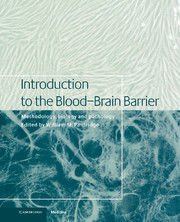1 - Blood–brain barrier methodology and biology
Published online by Cambridge University Press: 10 December 2009
Summary
Introduction
The blood–brain barrier (BBB) is formed by the brain capillary endothelial cell. In addition to brain endothelial transport processes, BBB research encompasses all of brain microvascular biology. The latter involves the interaction of the capillary endothelium with microvascular pericytes, neuronal inputs, astrocyte foot processes, perivascular microglial cells, and circulating leukocytes. Since the BBB forms the interface between blood and brain, the biology of the BBB plays a role in multiple disciplines other than the neurosciences, including pharmacology, physiology, pathology, and internal medicine. Despite the important role played by the BBB in so many fields, the number of laboratories worldwide engaged in BBB research is comparatively small. The relative underdevelopment of BBB research has important implications for the practical application of advances in the neurosciences (see last section of this chapter). However, this underdevelopment provides opportunities for young scientists to enter into a new area of neuroscience research.
The proposition that BBB research is still markedly underdeveloped, compared to other sectors of the neurosciences, may be examined from the perspective of the large number of areas in BBB biology that have both great significance for understanding how the brain functions and a relatively thin or nonexistent knowledge base. Table 1.1 lists ten such problems.
- Type
- Chapter
- Information
- Introduction to the Blood-Brain BarrierMethodology, Biology and Pathology, pp. 1 - 8Publisher: Cambridge University PressPrint publication year: 1998
- 9
- Cited by



